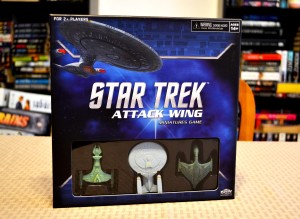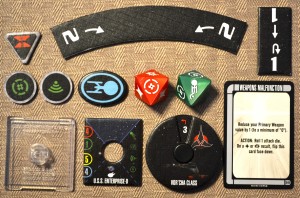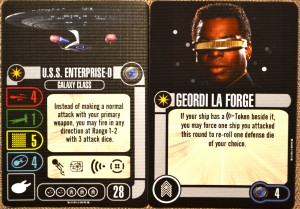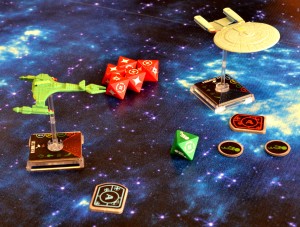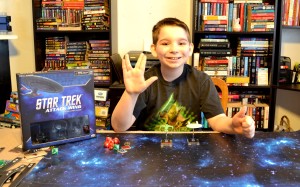I’ve been so engrossed with the “Star Wars: X-Wing Miniatures Game” that I almost let this one slip by. This would have been bad, seeing as how I can recite almost every “Star Trek” episode by heart, whether it be “Enterprise”, “TOS, “TNG”, “DS9”, or “Voyager” (come to Quark’s, Quark’s is fun, come right now, don’t walk – run!). Yeah, I’m kind of a nerd that way. At any rate, I was extremely surprised to learn just how similar these two products are…that is, “Star Trek: Attack Wing” and the aforementioned “Star Wars” game. I almost didn’t have to look at the manual…almost. With that being said, let’s take a quick look at what comes in the box and how the game is played before I share my final thoughts on the matter.
Components
Ships – The game includes three plastic painted ships: the USS Enterprise-D (Federation), the IKS Math-H’a (Klingon), and the IRW Khazara (Romulan). They each have plastic bases and accompanying pegs for support, as well as ship tokens to place on said bases. These three ships, for those of you curious, are from the “TNG” era.
Maneuver Dials, Cards, and Templates – Each ship has its own unique maneuver dial, based on the maneuverability of the ship class or type in question. The templates are either straight, banks, or turns and range from one to five (with one being the shortest while five being the longest). The game also comes with maneuver cards…these serve as a guide so that players don’t have to keep rotating their wheel to check if a particular maneuver is available.
Ship, Captain, and Upgrade Cards – When drafting a team, players will be choosing a ship along with a captain to pilot her. Upgrade cards do as they suggest, allowing players to upgrade their ship with unique abilities. Each of these cards list a cost value, which is used during the drafting process so that players have an equal chance of winning.
Dice – There are five red attack dice and five green defense dice, each with different symbols/icons.
Range Ruler – This two-sided ruler is used to measure distances during the game. As a general rule, attackers at range “1” get to roll an extra attack die while defenders at range “3” get to roll an extra defense die (primary weapon only).
Damage Cards – These are dealt to ships as their hull takes damage. Face-down damage cards represent regular damage, while face-up damage cards represent a critical hit. Face up damage cards list some type of penalty that the ship must observe.
Tokens – There are too many to list here…suffice it to say that there are plenty to choose from and they all serve to track things to help players stay organized. A few, like the planet or minefield tokens, are used for scenarios and/or as obstacles.
Expansions (not included): The market is saturated with different ships in the form of expansion packs. They each come with a ship, cards, and tokens for players to add to their collection.
Setup & Gameplay
First, players will choose a faction. After that, players will build a fleet observing the costs located on the ship, captain, and upgrade cards. The manual suggests a forty point game for those that only own this starter set, though players are free to try out different build cap values. Players assemble the ships and prepare the other components appropriately, placing the former on their side of the 3×3 playing area. The game doesn’t include a mat, so use your best judgement or buy/build your own.
The game is played over a series of rounds, consisting of:
1) Planning Phase: Each player secretly chooses one manuever per ship by using that ship’s maneuver dial. When they’re done, they lay the maneuver dial(s) face down.
2) Activation Phase: Each player reveals their dials, one at a time, and moves their ships using the corresponding maneuver template. The order in which this is done is determined by the captain skill (as listed on the captain cards). Players will resolve movement in ascending order. After moving a ship, a player may take one action by placing the corresponding token near their ship (there are exceptions).
3) Combat Phase: Each player can make one attack per ship, assuming that the enemy is within both range and the ship’s firing arc. The order in which this is done is determined by the captain skill (as listed on the captain cards). Players will resolve combat in descending order. There’s a list of steps involved with this phase, but suffice it to say that players will roll attack and defense dice (the number of which depends on the a number of factors). Any hits will first remove shield tokens from play, then will hit the hull. Hull strikes reward that ship with damage cards and when the number of damage cards exceed the hull value, the ship is destroyed.
4) End Phase: This is essentially a clean up phase. Disabled cards/tokens (in most cases) are flipped to their active side, unused action tokens are removed from play, cloak tokens are resolved, and so on.
Rounds will continue until the objective is satisfied (or when one team has no more ships on the playing field). I admittedly left a lot of stuff out, but it was necessary to keep the review at a respectable length. Still, it should give you a general idea as far as how the game is played. For more information, you can check out the rulebook here:
http://wizkidsgames.com/wp-content/uploads/2013/07/STAW_Rules_WEB_11sep13.pdf
The Review
As an experienced “Star Wars: X-Wing Miniatures Game” vet, I was able to pick this game up in no time flat. I’ll go as far as to say that if you know how to play the aforementioned “Star Wars” game, you’ll know how to play this. They are almost identical in terms of rules and play styles, though there are differences. The ships in this game have a higher attack value, it seems, while maintaining a lower defense value. This stands to reason, seeing as how “X-Wing” primarily consists of smaller starfighters. The actions are similar but have different names…evasive manuevers instead of evade tokens, battle stations instead of focus tokens, sensor echo instead of barrel roll actions, and so on. The scan and cloak actions are new however, giving me some different tactical options to consider. Overlapping ships can actually target one another, but come about (k-turn) manuevers still turn into a straight manuever during a collision. Rather than just picking a pilot card, you’ll get both a ship and a captain which simply takes some getting used to.
With regards to the components, my only real complaint was with the miniatures themselves and with the manuever dials. The miniatures were “okay”, but didn’t jump out at me the way the “Star Wars” minis did. The rest of the components were appropriately themed, but the manuever dials just wouldn’t stay together. On top of that, I received four bottom maneuver dial connector pieces and two top maneuver dial connector pieces forcing me to request replacement parts. The ship cards have the same layout as the “Star Wars” pilot cards, so I didn’t have to really learn anything new. New players to the game though should find it all fairly self-explanatory in that each ship has an attack, defense, hull, and shield value. They also have actions that they can perform as well as special abilities, though not all ships can do the same things. The rulebook is about fifteen pages give or take and there is a learning curve, so I highly recommend reserving a few extra hours if you’re new to the game and have never played “Star Wars: X-Wing Miniatures Game”. The general premise and turn order is simple, but all the different tokens, terms, and abilities do take some getting used to.
I’ll attempt to keep this short and sweet: “Star Trek: Attack Wing” is a great investment overall and you should seriously consider picking it up if you enjoy battling with miniatures, love the “Star Wars: X-Wing Miniatures Game”, or watch “Star Trek” with a passion. As I’ve come to learn, miniatures can get rather expensive. Be warned that in order to expand your game further, you’ll need to drop some serious cash…about fifteen bucks per ship, on average. To be fair, this is on par with its sister game, as most starfighters there also cost about fifteen bucks per ship. You can certainly play the game without buying any miniatures, but you’ll soon crave more ships, captains, and upgrade cards to mix into your fleet…once that happens, you might as well kiss your paycheck goodbye. Still, as both a “Star Trek” fan and an avid “Star Wars: X-Wing Miniatures Game” player, I don’t regret this purchase. “Star Trek: Attack Wing” is indeed a lot of fun and serves as a nice break from our “Star Wars” gaming sessions, though the quality of the miniatures and manuever dials could be better.
Final Verdict: 7/10
—
—
You can check out my “Star Trek: Attack Wing” video series here:
http://www.youtube.com/playlist?list=PLy-_-0rh3dPrApRHVamlr3PsNV3SS0ReE
—

